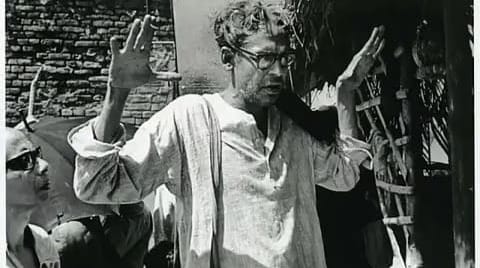REVIEW OF DWAU ANTHYRANGAU

The greatest stories are often those that do not allow us to pick a side. Perhaps it is for this very reason, that the two greatest epics of India, have survived millennia and continue to haunt, tease and guide the hearts of men. History is always the tale of the victor. The Indian culture always had embodiments in the form of magnanimous personalities. Rama the ideal man, Krishna the ideal lover, Yudhishtira the righteous man and the symbolism never ceases. Saranjith through his enactment of Bhasa’s play, relives seven icons of Indian legend.
He first embraces the formidable Duryodhana set in the context of the death duel with the mighty Bheema, for the decider of the great war. Despite Duryodhana sparing a defeated Bheema, the scion of Pandu, under instructions from Krishna, cheats to fatally injure the Kaurava King with an uncouth swing of the Gadha at the genitals. Saranjith switches with ease between Duryodhana and Bheema enacting pain, anger, frustration and confusion. A particular scene that haunts me even now is Duryodhana’s shriek of excruciation upon the fatal blow, which Saranjith executed so dexterously that I am unable to articulate its brilliance. Next, the invincible Balarama inebriated with alcohol and anger lashes out into the battlefield to avenge the treachery by one disciple to another. When Duryodhana reveals Krishna to be the traitor, Balarama however quivers due to the conflict of honor and love for kin. The relentless performer that Saranjith is, switches to the Threthayuga, taking the spectator to the battle in the forests on the outskirts of Kishkinda, to yet another death duel between Bali and Sugriva, where another “righteous man” slays the unconquerable Bali from behind the bushes. Despite Bali’s interminable questions on the morality of the deceit, Ram arrogantly castes aside all accusations justifying his act as the duty of a Kshatriya against an animal of the forest. Saranjith at this point is polarizing his emotional centers alternating between the dying Bali and the desperate Ram. Even the actor’s fine body movements have endless emotions to convey. During the enactment of death, his morbidity is exceptionally convincing that one wonders if this man is dead after all. He utilizes the methods employed by the performers of Kudiyattam to depict death starting from the lower body, a feat that can only be mastered after years of study.
At the end of both these tales, Saranjith closes the scenes with a note of forgiveness from the side of the dying warriors to express the ephemerality of human lives and emotion that is brought about by death. In the final act, Saranjith becomes the immortal Ashwathama, son of Drona and the symbol of anger and desperation. Ashwathama learns of the Pandavas’ treachery. He is angered that victory has gone to the side of deceit, when he lost both his father and his King to deception. The artist dazes us through his portrayal of anger with subtext of frustration and helplessness. The epilogue shows us the actor questioning the audience-what is right and what is wrong? Dharma or Chala? He utilizes the Mizhavu, a percussion instrument from the performance art of Kudiyattam, to signify the END. Stripping down to his bares, he carries away the Mizhavu on his shoulders symbolizing that man leaves behind all earthly possessions in death.
Saranjith’s performance is captivating not just because of his dialogues. The actor’s manipulation of every muscle in his body from head to toe not only overwhelms us with an act of singular perfection, but at the same time leaves us unsettled asking ourselves the unanswerable question……..




